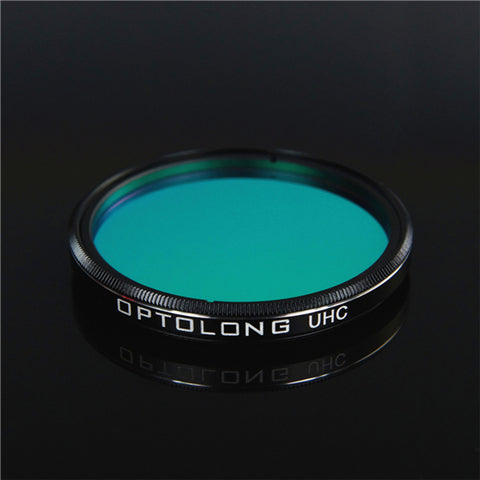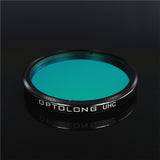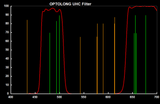Yes, our inventory is accurate!
![]() Qualifies Towards Free Ground Economy Shipping (CONUS Only) For Most Orders Of $79 Or More
Qualifies Towards Free Ground Economy Shipping (CONUS Only) For Most Orders Of $79 Or More
The UHC (Ultra High Contrast) broadband filter is designed to improve the visibility of various deep sky objects by selectively reducing the transmission of wavelengths of light pollutants. Specifically, it reduces those produced by artificial lighting, including mercury vapor lamps, both high & low pressure sodium vapor lights, and the unwanted natural light caused by neutral oxygen emission in our atmosphere (i.e. skyglow).
The UHC filter is highly transparent in the main nebula emission lines at OIII (496nm and 500nm), H-beta (486nm), NII (654nm and 658nm), H-alpha (656nm), as well as SII (672nm). The UHC filter enhances the contrast and details for both visual and photographic purposes in areas with heavy light pollution.
Main Use and Performance
- Suitable for color CCD cameras and unmodified DSLRs.
- The UHC filter, with a narrower passband, provides higher contrast than the CLS filter. Thus it is more suitable for urban environments which suffer from severe light pollution.
- The UHC filter has a substantial red passband and offers superb views for objects like the Orion Nebula (M42)
- Light pollution filters do not eliminate the effects of light pollution or increase the object’s brightness. In many cases, they increase the contrast between nebula and night sky, but without brightening the nebula.
Which to Choose?
- L-Pro provides the broadest spectrum and most natural color. Suitable for imaging nebula and galaxy targets.
- UHC is not as broad spectrum, less natural color, but will block more stray light and skyglow than the L-Pro. Best suited to nebula targets, not broad spectrum targets like galaxies or clusters.
- L-Enhance is a narrow tri-band filter. Best suited to capturing dim nebula targets. Will decrease brightness of surrounding stars, allowing for more faint detail.
If you plan to use the filter to image a wide range of targets, the L-Pro is the most versatile. The L-Enhance will provide the most faint detail on emission nebula, and the UHC is a budget option in the middle.
Technical Data
- Schott substrate material
- Thickness 2.0 mm (1.25”/2”/36mm/77mm/82mm)
- Thickness 1.0 mm (Clip series)
- Surface Quality: 60/40 (Refer to MIL-O-13830)
- Optically polished to ensure accurate 1/4 wavefront and <30 seconds parallelism over the both surfaces
- 95% transmission of main nebula emission lines (i.e. H-alpha 656nm, OIII 496nm and 500nm, SII 672nm and H-beta 486nm
- 0.1% transmission of off-band, specifically the major emission lines of artificial light pollution (i.e. Na 589nm, Hg 435nm and 578nm). Transmission of 0.1% is equivalent to OD3(Optical Density), where a high optical density value indicates very low transmission, and low optical density indicates high transmission.
Coating Parameter
- Multi-layered anti-reflection coating
- Non-cemented optical substrate coating
- Electron-beam gun evaporation with Ion-assisted deposition coating technology for durability and resistance to scratching, as well as stability on CWL (central wavelength); no deviation affected by temperature change
- Planetary rotation system offers precision and homogeneity of coatings ensuring high value on transmission of pass-band and Optical density of off-band
Filter Cell
- Ultra-thin filter cell minimizes vignetting by maximizing possible clear aperture (clear aperture is 26mm for 1.25”; 45mm for 2”)
- Aerometal Material
- Precise CNC Machining
- Sand Blasting Process
- Black Anodized Finish
- Extinction Treatment to Prevent Reflection
- Laser Engraving No Fading
Package
- Plastic PP Case
- Imported High Pressure EVA Case Lining
- Silver Cardboard Box
- High Density Sponge Carton Lining
Sizes
- Standard 1.25”
- Standard 2”
- Clip Filters for crop sensors and full sensors
Spectral Curve (see image)
- Transmits the major emission lines of nebulae
- H-β 486.1nm, OIII 495.9nm, OIII 500.7nm, H-α 656.3nm
- Blocks the major emission lines of artificial light pollution
- Mercury (Hg): 435.8nm, 546.1nm, 577nm, 578.1nm
- Sodium (Na): 598nm, 589.6nm, 615.4nm, 616.1nm



